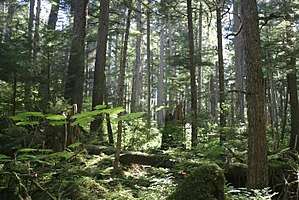Forests of the United States
It has been estimated that before European settlement, forests in the United States covered nearly 1 billion acres (4,000,000 km2).[1] The arrival of Europeans, however, caused a decline in native populations, and since the natives were largely agricultural, this caused reforestation of agricultural lands.[2]
Nationalatlas.gov says the following:
"Since the mid-1600s, about 300 million acres (1,200,000 km2) of forest have been cleared, primarily for agriculture during the 19th century."[1]
Background
As of 2016, roughly 36.21% (about one-third of the U.S.) is forested.[3] Excluding the U.S. territories, forested land in the U.S. covers roughly 818,814,000 acres (3,313,622 square kilometers).[3] As of 2005, the United States ranked seventh in the rate of loss of its old growth forests.[4]
Nationalatlas.gov says the following:
"While total forest area has been relatively stable for the last 100 years, there have been significant regional shifts in the area and composition of the nation's forests. Reversion of marginal farmland in the east, large scale planting in the South, and fire suppression have contributed to increases in forest area. Urbanization, conversion to agriculture, reservoir construction, and natural disasters have been major factors contributing to loss of forests."[1]
"Eastern forests cover about 384 million acres (1,550,000 km2) and are predominantly broadleaf (74%), with the exception of extensive coniferous forests and plantations in the southern coastal region. These are largely in private ownership (83%). By contrast, about 363 million acres (1,470,000 km2) of western forests are predominantly coniferous (78%) and in public ownership (57%). Nearly ten million private individuals own about 422 million acres (1,710,000 km2) of forest and other wooded land. Most public forest land is held by four Federal agencies (United States Forest Service, Bureau of Land Management, National Park Service, Fish and Wildlife Service) as well as numerous state, county, and municipal government organizations."[1]
"Major uses of forests include timber production, recreation, hunting, fishing, watershed and fisheries protection, wildlife habitat and biodiversity protection, and gathering nontimber products such as berries, mushrooms, and medicinal plants."[1]
There are boreal forests in Alaska.[5] Forests in Hawaii and the U.S. territories are tropical.[6]
The most heavily-forested regions of the U.S. are Maine, New Hampshire, American Samoa, the Northern Mariana Islands and West Virginia; the least heavily forested regions are North Dakota, Nebraska, and South Dakota.[3]
Invasive species
Projects have been undertaken to remove invasive species from forests in the U.S.; for example, in the U.S. Minor Outlying Islands, rats were successfully eradicated in the tropical forest on Palmyra Atoll. [7]
See also
- Deforestation in the United States
- Forest cover by state and territory in the United States
- François André Michaux, a botanist noted for his work on the trees found in America
- Hawaiian tropical rainforests
- List of U.S. National Forests
- National Park Service
- Senate Committee on Forest Reservations and the Protection of Game
- United States Forest Service
References
-

- Simon Lewis; Mark Maslin (Mar 11, 2015). "Defining the Anthropocene". Nature. 519: 171–80. doi:10.1038/nature14258. PMID 25762280.
- https://www.fs.fed.us/sites/default/files/fs_media/fs_document/publication-15817-usda-forest-service-fia-annual-report-508.pdf
USDA - Forest Inventory And Analysis Fiscal Year 2016 Business Report. Page 71-72 (Page 79-80 of PDF). Table B-11. Land and forest area and FIA annualized implementation status by State and region, FY 2016. Data for territories: Table B-10. Status of FIA special project areas excluded from annualized inventory. Retrieved January 8, 2019. - "Global Forest Resources Assessment 2005". UN Food and Agriculture Organization. 2005.
- https://www.borealbirds.org/boreal-forest Boreal Songbird Initiative. Boreal Forest. Retrieved January 8, 2019.
- https://www.princeton.edu/~ota/disk3/1984/8426/842609.PDF Princeton.edu. Chapter 6 - U.S. Tropical Forests: Caribbean and Western Pacific. Retrieved January 8, 2019.
- https://phys.org/news/2018-07-percent-native-trees-rat-free-palmyra.html
Study shows 5,000 percent increase in native trees on rat-free Palmyra Atoll. July 17, 2018. Retrieved January 8, 2019.
External links
| Wikimedia Commons has media related to Forests in the United States. |
